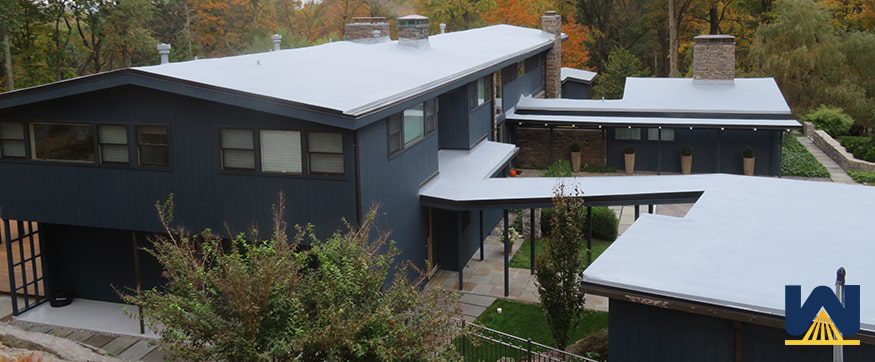There are situations in life that just don’t work out. For example:
- Not everyone can be a professional athlete
- Not everyone can have children
- Not everyone will have a chance to travel to Hawaii
While some situations don’t work due to born talent, health, or financial issues, that’s just what life throws at us sometimes.
The same (while not as personal) can be said about getting a spray foam roof.
Sometimes, a spray foam roof just isn’t the greatest fit for your building.
The three reasons a spray foam roof won’t work for your building is:
- Your building is a high-risk for overspray
- Your roof is small and faraway from a spray foam roofing contractor
- Your building is residential
Since West Roofing Systems has been spraying foam roofs on all kinds of buildings for more than 40 years, we know when it makes sense to install a spray foam system, and when it’s not.
Today’s we’ll dive into these three situations and explain why a spray foam roof is not a good fit.
Let’s begin…
Reason #1 – Your building is high-risk for overspray
First, what is overspray?
Since a spray foam roof is installed by…spraying foam, the liquid is lightweight and can easily be carried away with wind.
That substance can travel and land on expensive items, most commonly vehicles, which require precise detailing to remove.
Here is an example of overspray on a vehicle:

Notice the tiny white specs. That’s over-sprayed spray foam.
I’m not sure what speed of wind is needed for spray foam to “overspray” but it’s a constant issue if there’s no overspray protection.
A roofing contractor tries to eliminate overspray by physically holding windscreens:
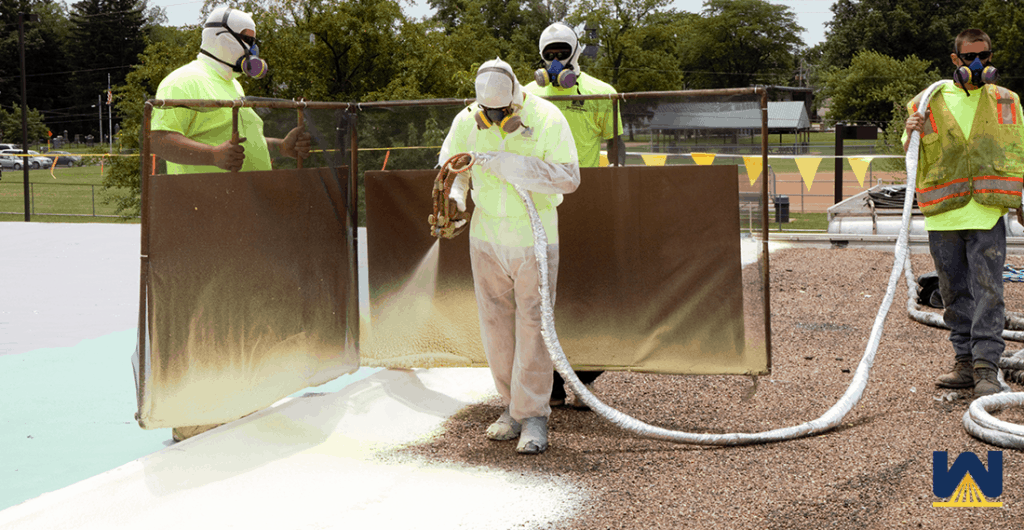
Or by spraying out a booth:
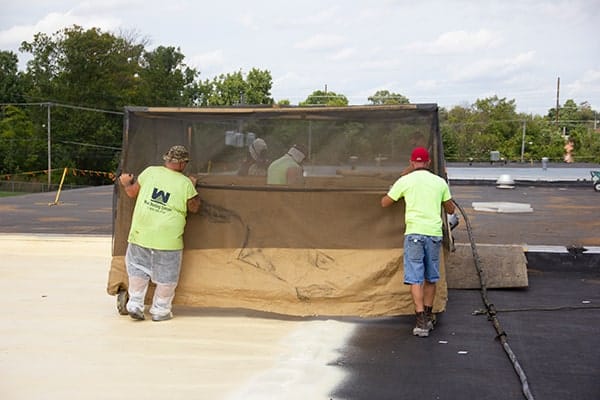
The downfalls of handling precautions with overspray is that it usually requires additional labor, and it always slows down production.
For that reason, dealerships that have hundreds of vehicles surrounding the roof aren’t the best fit for a spray foam roof.
NOTE: A roofing contractor will pay for the detailing of any vehicle that happens to get overspray.
Reason #2 – Your roof is small and located far from a spray foam roofing contractor
The reason this is an issue is that at certain distances, it doesn’t make sense for a roofing contractor or the building owner to work together who are too far apart.
Gas, vehicle wear and tear, labor hours wasted driving, and housing are all avoidable or greatly reduced by using a local contractor.
But what distance is too far away?
This all depends on the size of your roof.
For a 2,000 sq. ft. roof, the roofing contractor should be close. For a 200,000 sq. ft. roof, the roofing contractor can be much further away.
The reason is the percentage of overhead that goes into the job.
For a 2,000 sq. ft. roof that’s 300 miles away, overhead may be 50% of the cost of the job. Since spray foam is around $4-$7 per sq. ft. (let’s use $5 as an example), you would pay $10,000 if the roofing contractor was next door vs $20,000 if they were 300 miles away.
Say a 200,000 sq. ft. roof is also 300 miles away.
The cost for spray foam ($5/sq. ft.) for this roof is $1,000,000 and the overhead is the same as the previous job ($10,000).
2000 sq. ft. roof, overhead is 50% of the total cost of the job.
200,000 sq. ft. roof, overhead is 1% of the total cost of the job.
*In summary:
[table id=7 /]*Costs and overhead are estimated. If you’re looking for a SPFA (Spray Polyurethane Foam Alliance) roofing contractor in your area, use their online directory.
Reason #3 – Your roof is residential
99% of residential houses do not want a spray foam roof.
Why?
Aesthetics.
Spray foam is not the most attractive option out there, so most people tend to avoid it.
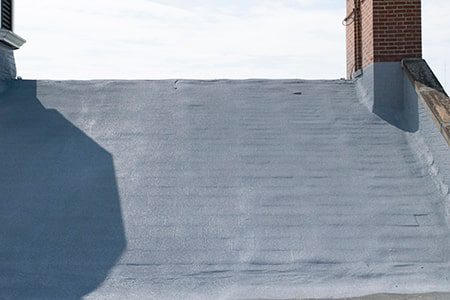
What most people do is use spray foam for insulation on the inside of their house and place a shingle roof over top.
But there are some residential houses that would like the energy saving properties of a spray foam roof.
For example, he’s a photo of a project called “Thor Mann Residence”, a historic home in suburban New York:
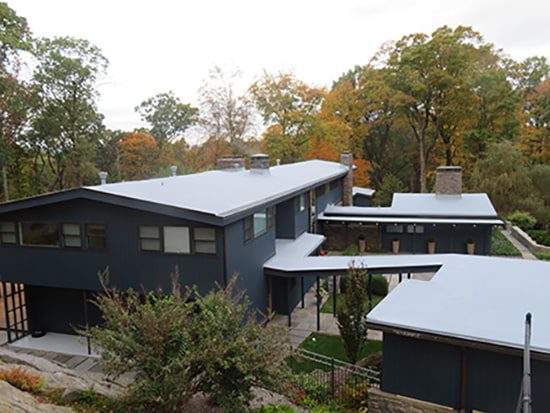
This residence is worth $1.8M and had a custom blended granule application embedded into the topcoat of coating.
Bonus Content: Efforts to find a bad candidate for a spray foam roof that didn’t work.
Buildings located in extreme climates
Spray foam has the greatest R-value of any roofing system per square inch.
Therefore, it’ll keep the cold AC from escaping a hot warehouse and it will keep the warm air from escaping a mall during the winter better than any other roofing system.
Buildings owners looking for the cheapest roofing option
Spray foam roofs cost anywhere between $5 and $10 per square foot. There are many, many variables that influence cost, such as:
- What are the current conditions of the roof?
- How high is the roof?
- How difficult it is to reach the roof?
- What kind of R value is expected of a new roof?
And much, much more.
But spray foam is priced competitively with any other roofing system.
Buildings owners looking only for a short-term solution
Spray foam is a renewable, “last roof you’ll ever have to put on” roofing system, but spray foam can also be a short-term solution.
Spray foam can be done sectionally if the building owner only has one area that’s leaking.
A spray foam roofing system can also be designed to make a roof last leak-free for 1-10 years until that building is demolished.
Building owners with Rubber or Gravel Built-up substrates
Spray foam can go over any existing substrate if it’s prepped the correct way.
For a rubber roof, a roofing contractor will check for wet insulation, remove the wet and replace with similar material, clean the rubber and spray foam overtop.
For a gravel built-up roof, a roofing contractor will check for wet insulation, vacuum the gravel off, clean and spray foam overtop.
Ready to learn more about spray foam roofing?
Today you learned that spray foam is not the greatest solution for roofs that have a high-risk of overspray, are small and located faraway from a roofing contractor, and/or that’re residential.
But did you know, West Roofing Systems has installed over 60 million sq. ft. of commercial roofing spanning over 40 years in business.
Clearly business owners see the benefits in installing a spray foam roof.
Here are some resources to get you started:
- Energy Savings and Spray Polyurethane Foam Roofs
- The 7 Advantages of a Spray Foam Roof
- What Problems Do Spray Foam Roofs Have?
And if you’d like to learn about the SPF basics quickly, please view our cheat sheet:

